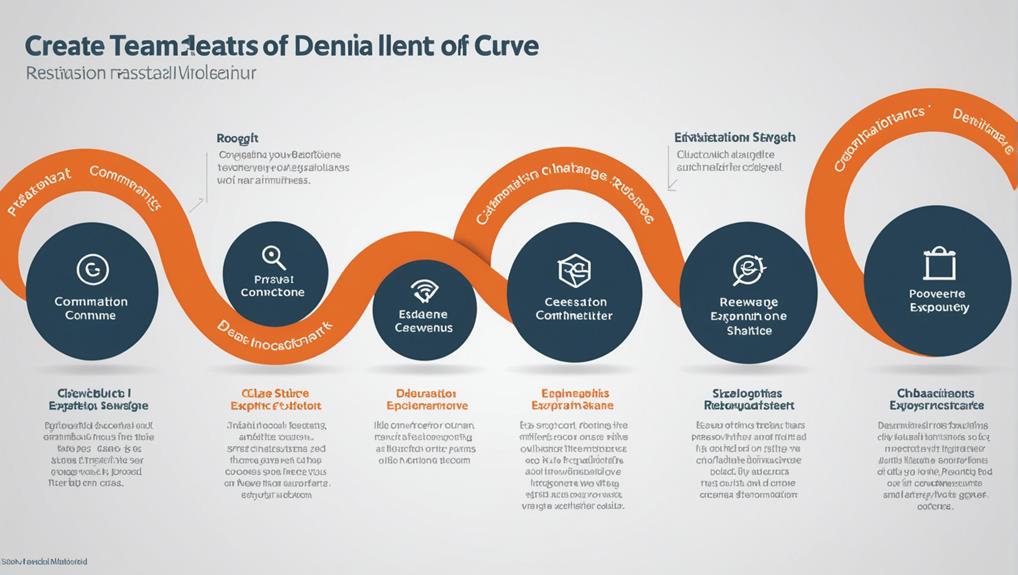Navigating through organizational change can feel like sailing through rough waters. Imagine having a reliable compass, like the Prosci Change Curve, to guide you through these uncharted territories. This tool helps you understand the emotional journey your team goes through during change, giving you the key to unlock strategic advantages that can help your organization stay strong amidst uncertainty.
But how does this framework actually help you harness the power of change and steer your organization towards smoother waters of productivity and success?
Well, think of it like this: the Prosci Change Curve acts as your trusty compass, showing you where you are in the change process and what emotions your team might be experiencing. Understanding these emotional shifts can help you anticipate challenges, address concerns, and keep your team motivated throughout the journey. It’s like having a roadmap that helps you navigate the twists and turns of change with confidence.
By using the Prosci Change Curve, you can proactively manage resistance to change and build resilience within your team. Instead of being caught off guard by negative emotions or pushback, you can address them head-on and guide your team towards acceptance and commitment to the change. This proactive approach can help you minimize disruptions, boost morale, and keep productivity levels steady during times of transition.
Ultimately, the Prosci Change Curve empowers you to lead your organization through change with clarity and purpose. It helps you see the bigger picture, understand the human side of change, and make informed decisions that benefit both your team and the organization as a whole. So, by embracing this framework, you can steer your organization towards calmer seas of productivity, success, and resilience in the face of change.
Key Takeaways
Predictable employee responses help with managing changes. When employees know what to expect, it can make transitions smoother. It’s like having a roadmap that guides everyone through the process. This predictability can reduce uncertainty and resistance, making it easier for the organization to implement changes successfully.
When an organizational culture is more resilient and adaptable, it can better handle challenges and changes. It’s like having a flexible mindset that can adjust to different situations. This adaptability allows the organization to pivot quickly when needed and stay competitive in a constantly evolving environment.
Tailoring strategies to support employees during transitions is crucial. Each individual may have different needs and concerns during times of change. By customizing support strategies, you can address specific issues and ensure employees feel valued and heard. This personalized approach can boost morale and engagement, fostering a positive transition experience.
Effective communication is key to aligning everyone during change initiatives. When information is clear, transparent, and consistent, it helps employees understand the reasons behind the changes and their role in the process. This alignment ensures everyone is on the same page and working towards the same goals, promoting unity and collaboration.
Navigating through different stages of organizational change can be challenging. By having a well-defined plan and clear milestones, the organization can progress smoothly from one stage to the next. It’s like following a roadmap with signposts that show progress and keep everyone moving in the right direction. This structured approach can minimize disruptions and ensure a successful transition.
Overview of Prosci Change Curve
The Prosci Change Curve Overview helps us understand the emotional journey people go through during organizational changes. It breaks down the process into four stages: Denial & Shock, Fear & Anger, Exploration, and Acceptance. Recognizing these stages can help organizations manage change more effectively and achieve successful implementation.
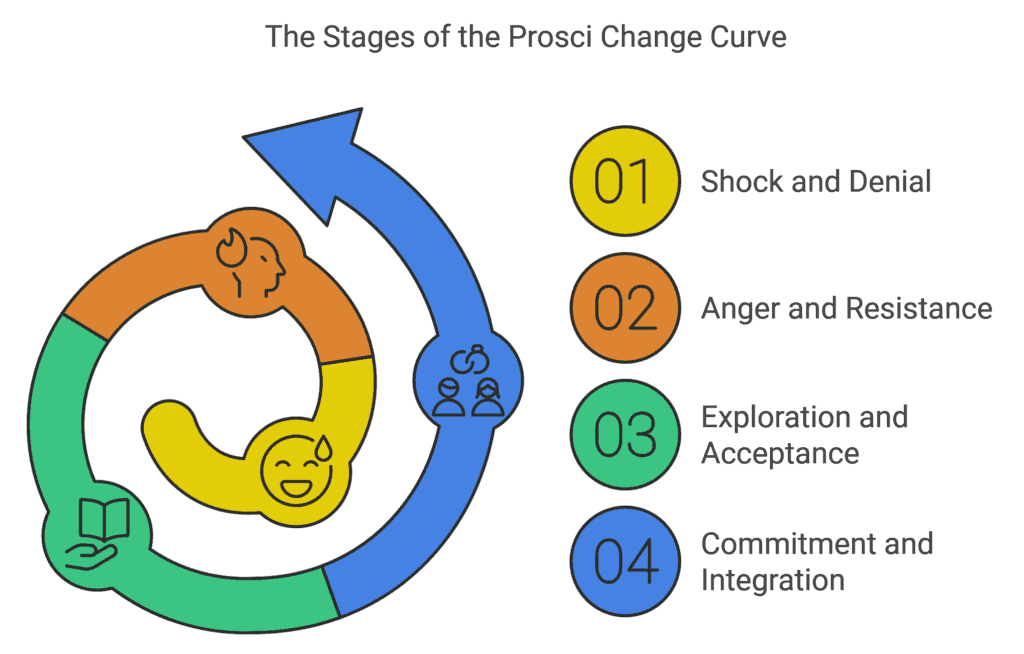
In practical terms, each stage is crucial for the change management process to succeed. By acknowledging and addressing employees’ emotions as they progress through these stages, leaders can ensure a smoother transition and higher levels of acceptance. Understanding how individuals react to change is key to developing strategies that support them throughout the transformation.
Key Principles of Change Curve
If you want to understand why the Change Curve model is so crucial, you should start by looking at its core principles. These principles are the foundation that helps organizations effectively manage change. By getting a good grasp of these key ideas, you can see how they play a significant role in guiding organizations through successful change initiatives.
So, what’re the basics of the Change Curve? Well, when you delve into the fundamentals of this model, you can learn how to use it strategically to drive positive transformations within your organization. It’s all about leveraging the Change Curve to navigate through change in a way that brings about meaningful and lasting results.
In essence, by understanding and applying the principles of the Change Curve, organizations can better equip themselves to adapt and thrive in times of change. It’s like having a roadmap that helps steer you in the right direction when faced with challenges and uncertainties. Ultimately, it’s about using this model as a tool to foster growth and resilience within your organization.
Change Curve Basics
Developed by Elisabeth in the 1960s, the Change Curve helps us understand the emotional journey individuals go through when faced with change. It’s like a roadmap that shows us the different phases people experience during times of transformation. This model is super useful because it helps us predict how employees might react to change. By knowing what to expect, we can come up with better strategies to manage change effectively.
When we look at how employees feel and what they go through during change, we can better prepare and support them. This is crucial for organizations because it helps teams navigate through shifts more smoothly. Understanding the Change Curve is especially important when we’re talking about how new technologies impact companies. It helps us understand why some teams might be resistant to trying out new tools and processes. By using the Change Curve, we can get valuable insights that will help us drive successful change initiatives.
Impact on Organizations
Managing organizational change with the Prosci Change Curve means understanding and addressing how employees react emotionally to the change. This helps in developing tailored change management strategies to support them through the process.
So, how can Impact on Organizations benefit your organization? Well, let’s break it down:
- Predictability: By using the Change Curve, organizations can predict how employees might respond to the change. This allows them to be proactive in managing the transition effectively.
- Increased Resilience: Knowing where individuals are on the change journey helps organizations in fostering resilience and adaptability within their workforce. This is crucial for navigating through change smoothly.
- Effective Communication: When organizations tailor their change management strategies based on the emotional phases model, it improves communication. This, in turn, fosters a sense of belonging and alignment among employees during times of change.
Impact on Change Management Strategies
When you think about Change Management Strategies and how they impact your efforts, it’s crucial to consider how they align with the stages of the Change Curve.
By tailoring your strategy to match the various reactions employees might show, you can create engaging tactics that help people accept and adapt to changes smoothly.
Understanding how the Change Curve affects change management allows you to address resistance proactively and steer your team towards successful adjustment.
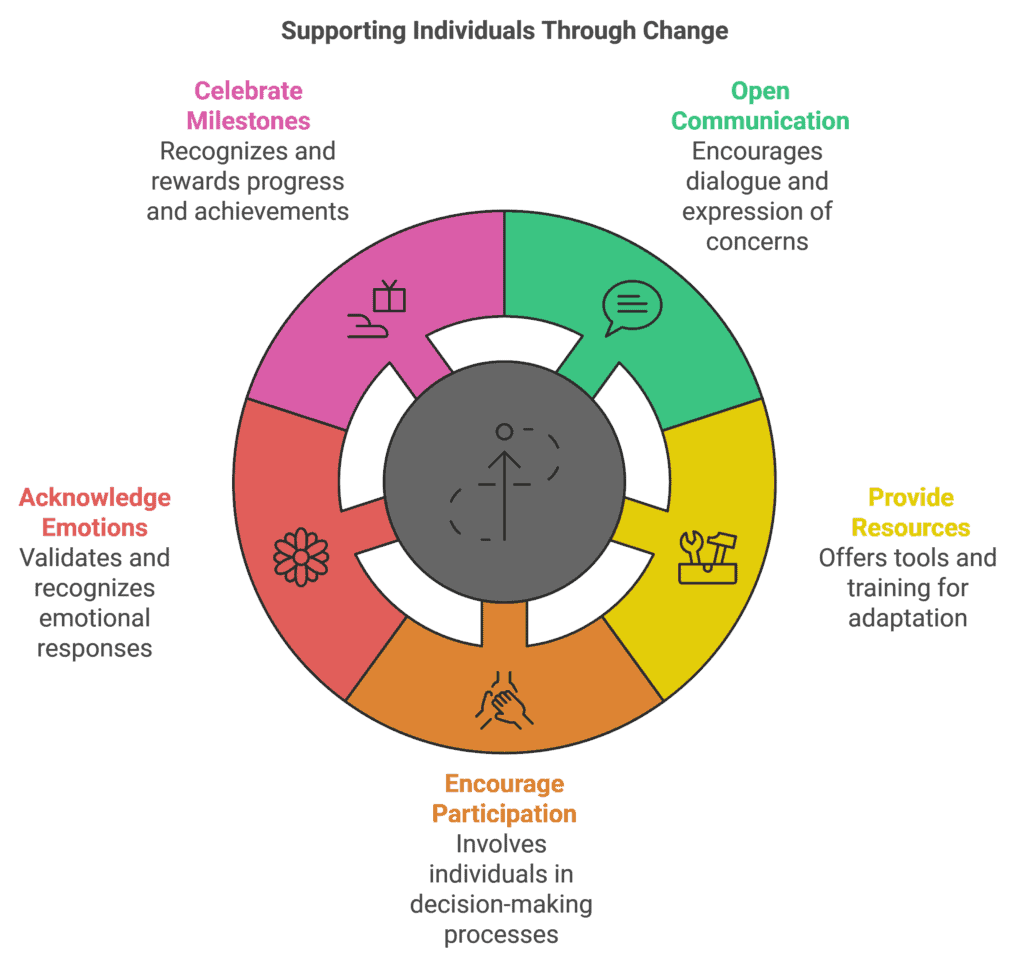
Strategy Alignment Importance
When your organizational goals match up with your change management strategies, you set yourself up for success. It means that everyone is on the same page, working towards the same objectives. This alignment is crucial for making sure your transformation efforts go smoothly and that people actually embrace the changes you’re making.
Why is it so important to get your goals and strategies in sync? Well, for starters, it gives you a clear direction. When everyone is aligned, it’s like having a roadmap that guides you through the change process. This clarity makes it easier for everyone to understand what needs to be done and why.
Another big benefit of aligning your strategies is that it makes communication a whole lot better. When everyone is singing from the same hymn sheet, there’s less room for misunderstandings and resistance. People know what’s happening, why it’s happening, and what their role is in the whole thing.
Lastly, when your goals and strategies are in harmony, you’re more likely to see improved employee engagement. When people feel like they’re part of something meaningful and that their contributions matter, they’re more likely to get on board with the changes. This sense of purpose and belonging can really boost morale and commitment during the change process.
Employee Engagement Strategies
Employee engagement strategies are crucial for the success of change management initiatives in any organization. When employees are engaged, they’re more likely to embrace new processes and technologies, which is essential for a smooth transition during periods of change. The Prosci ADKAR® Model underlines the importance of involving employees in change efforts to ensure their success. Let’s take a look at how employee engagement strategies can benefit change management:
Engaged employees can lead to a 21% increase in profitability for the organization. This is because when employees are actively involved and committed to the change process, they’re more likely to contribute positively to the bottom line.
Additionally, organizations with engaged employees tend to experience a 17% higher productivity rate. Engaged employees are motivated to perform at their best and are more likely to go above and beyond in their roles.
Employee engagement strategies also result in a 41% reduction in absenteeism. When employees feel connected to their work and are engaged in the change process, they’re less likely to call in sick or miss work.
Furthermore, organizations with engaged employees have a 59% lower turnover rate. Employees who are engaged and feel valued are more likely to stay with the organization, reducing turnover costs and ensuring continuity during times of change.
Lastly, employee engagement can enhance customer loyalty through positive experiences. Engaged employees are more likely to provide excellent customer service, leading to increased customer satisfaction and loyalty.
Enhancing Employee Reactions to Change
When it comes to helping employees deal with change, it’s important for organizations to communicate in a way that aligns with the stages of the Prosci Change Curve. By recognizing and addressing the emotions employees may experience during changes, you can make the transition smoother and increase acceptance of new initiatives.
Here are three key strategies to improve how employees react to change:
First off, make sure to communicate openly and transparently. Keep employees in the loop about why the change is happening, what they can expect during the transition, and how it will benefit both the organization and individuals.
Next, encourage active listening and provide feedback mechanisms. Let employees share their concerns, ideas, and feedback throughout the change process. By listening actively and incorporating their input, you can help ease fears and resistance.
Lastly, offer training and support programs. Providing adequate training and support can help employees navigate the change more successfully. Resources, workshops, and coaching can empower individuals to adapt effectively.
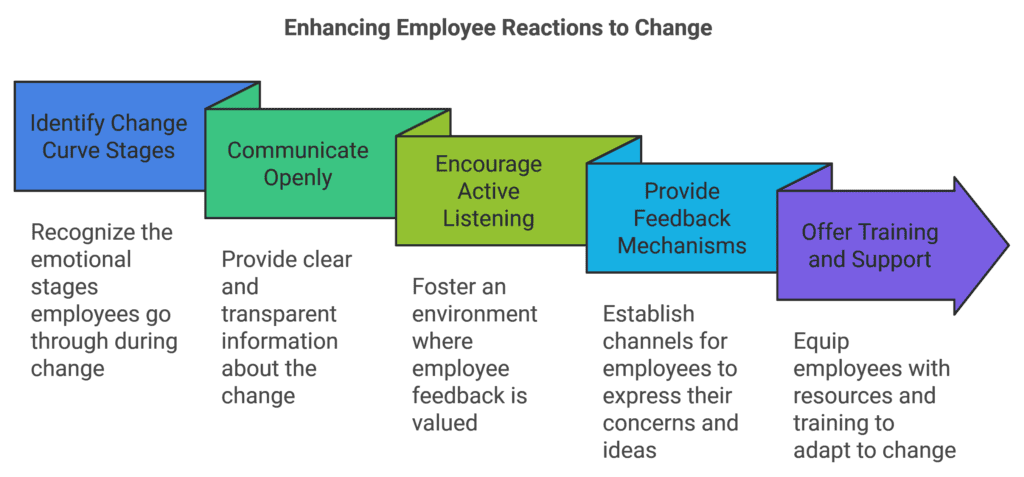
Navigating Emotional Phases Effectively
Understanding the emotional phases outlined in the Prosci Change Curve is crucial for helping individuals navigate through periods of change within an organization. The Prosci Change Curve, created in the 1960s, offers a structured way to predict and address employee reactions during transformations. By acknowledging the four stages of Denial & Shock, Fear & Anger, Exploration, and Acceptance, organizations can customize their approaches to effectively support employees.
Let’s dive into the emotional phases to see how we can guide individuals through them:
In the Denial & Shock phase, employees may resist change and feel disbelief. To help them through this, it’s important to communicate the purpose behind the change and provide them with the necessary support.
During the Fear & Anger stage, individuals might experience frustration and uncertainty. Addressing their concerns and offering training can help alleviate their feelings and guide them towards acceptance.
As individuals enter the Exploration phase, they may show curiosity and openness to the change. It’s beneficial to encourage their involvement and provide incentives to keep them engaged.
Tailoring Leadership Approach for Success
Adjusting your leadership approach based on the Prosci Change Curve is crucial for managing how employees react and ensuring that organizational change is successful. Adapting your leadership style to match the different stages of the Change Curve can significantly impact how your team handles changes.
Here are three key strategies to customize your leadership approach for success:
- Acknowledge Employee Emotions: Take note of and address denial, shock, fear, and anger in your team members. When you understand and validate their emotions, you can better guide them towards accepting and committing to change.
- Provide Support and Encouragement: Give positive feedback and emphasize the advantages of the upcoming changes during the Exploration stage. This helps to generate excitement and gain employee support for new processes.
- Guide Teams Towards Embracing Change: Use effective leadership methods that align with the Change Curve to help your teams embrace new tools and approaches. By offering clear guidance and encouragement, you can facilitate a smoother transition and ensure successful organizational change.
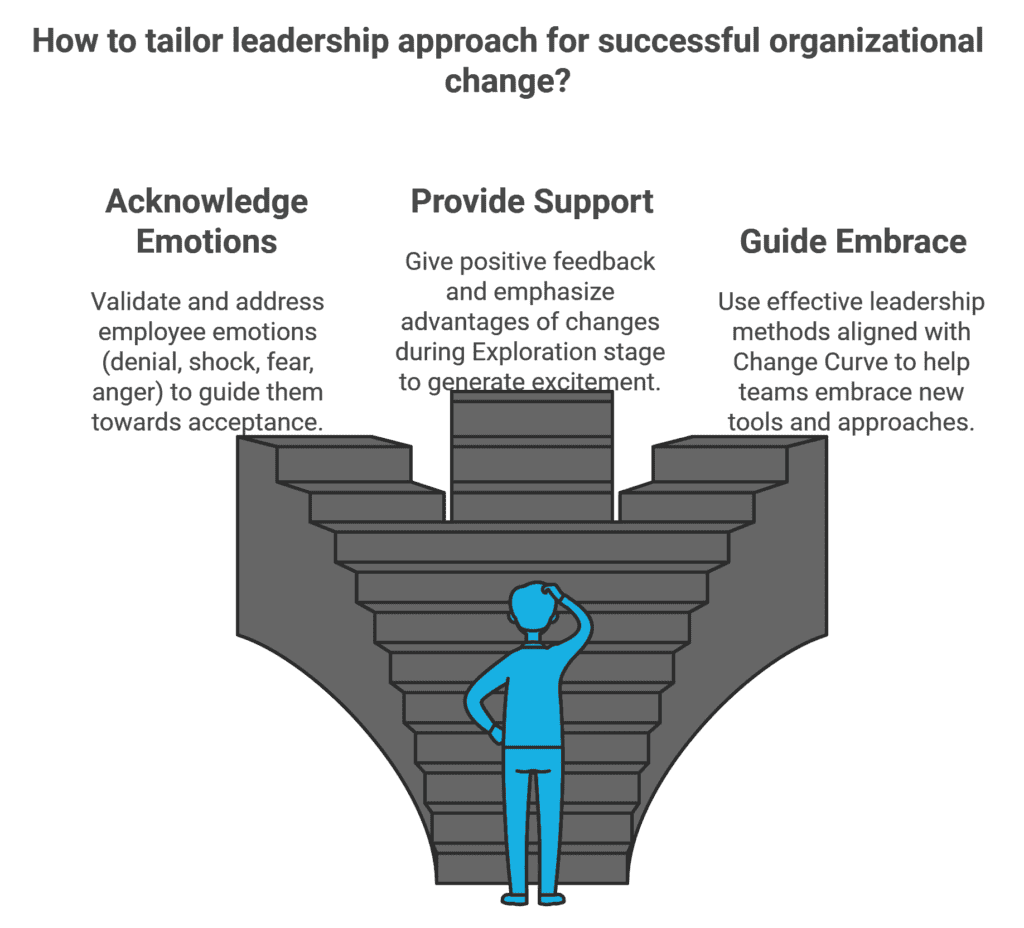
Frequently Asked Questions
What Are the Benefits of Change Management Prosci?
When people communicate better, employees get more engaged, making shifts run more smoothly. If you understand the Change Curve, you can better predict how people will react to changes, which helps the organization stay strong. Prosci Change Management can help create flexible systems and quick responses to changing situations.
What Will the Benefits of the Change Be to the Organization?
Surprisingly, when you lead changes in your organization, it can boost productivity, lift morale, improve communication, and open up more opportunities for innovation. By guiding your team through the Change Curve effectively, you can help them move towards success.
What Are the Benefits of the Adkar Change Model?
If you use the ADKAR Change Model, you can boost employee engagement and ensure successful implementation. This model helps make changes stick, streamlines processes, enhances communication, and makes transitions easier. It improves productivity, which is great for your organization’s success.
What Are the Benefits of Using a Change Management Approach to Implementing a Change in Benefit Programs?
When you make changes to benefit programs, it’s important to use a change management approach. This helps get employees on board, improves communication, ensures lasting results, and boosts productivity. By following structured methods like the Prosci Change Curve, you can make transitions smoother and increase the chances of successful adoption.
Conclusion
In short, when you understand the benefits of the Prosci Change Curve for your organization, you can predict reactions, tailor strategies, and foster resilience within your team.
This approach ensures smoother transitions, increased employee involvement, better communication, and successful implementation of changes for long-term outcomes.
By acknowledging the emotional journey of your employees and navigating through change phases effectively, you’ll ultimately drive organizational success and adaptability in the face of changing circumstances.


